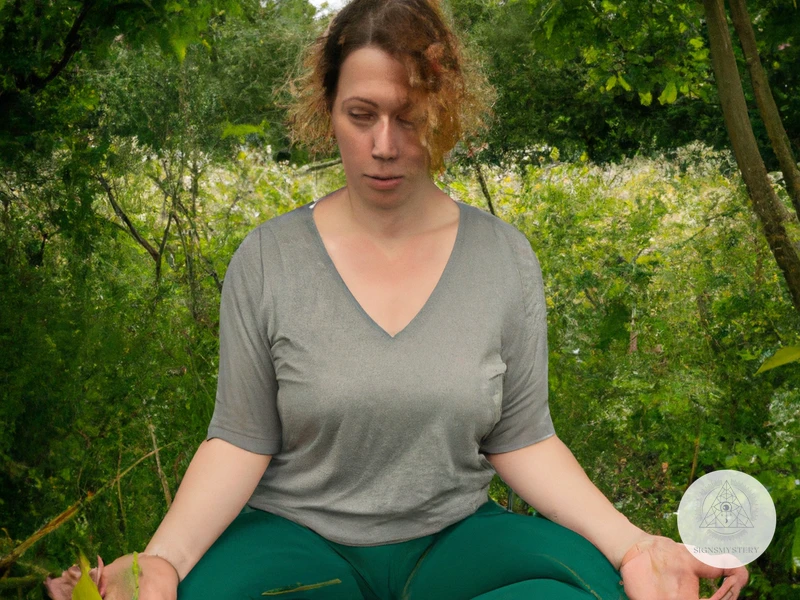Shamanic Breathwork is a unique technique that combines elements of shamanism, breathwork, and music to facilitate healing on a deep level. It has been used for centuries by indigenous cultures all over the world, and in recent years has gained popularity in the Western world as a powerful tool for healing trauma and emotional wounds. In this article, we will explore the history and practice of Shamanic Breathwork, as well as its many benefits for those seeking to release, heal, and grow. Whether you are new to Shamanic Breathwork or already a practitioner, this article will provide valuable insights and guidance for your journey towards wholeness and transformation.
What is Shamanic Breathwork?

Shamanic Breathwork is a powerful healing modality that combines deep breathing, ceremonial music and intentional movement to access non-ordinary states of consciousness. This technique has been used for thousands of years by indigenous cultures worldwide for physical, emotional, mental, and spiritual healing. During a Shamanic Breathwork session, the participant often feels a sense of connection with something greater than themselves and gains access to their inner wisdom for self-discovery and healing. Shamanic Breathwork can help release trauma and emotional wounds, increase self-awareness, lower stress and anxiety, and facilitate spiritual connection and awakening. For more information of the history of Shamanic Breathwork, read about the history of Shamanic Breathwork.
1. The History of Shamanic Breathwork Healing
Shamanic Breathwork Healing has been around for thousands of years and it is an ancient practice that has been passed down from generation to generation by shamans. The shamans believed that the breath is a powerful tool that can be used to alter consciousness and heal the body and mind. The use of the breath for healing is not only found in Shamanic traditions, but it is also found in other spiritual traditions such as Hinduism, Buddhism, and Taoism. Shamans used different techniques, including breathing and dancing, to enter a trance state where they could communicate with the spirit world to gain knowledge and insight.
Shamanic Breathwork Healing is a fusion of shamanic wisdom and modern therapeutic techniques. The foundations of Shamanic Breathwork were laid in the 1980s by Linda Star Wolf and the Venus Rising Association for Transformation. Linda Star Wolf’s work was influenced by the teachings of Carl Jung, Stan Grof, and Joseph Campbell. Shamanic Breathwork sessions usually take place in a group setting, and they involve a combination of deep breathing, evocative music, and expressive movement.
In Shamanic Breathwork, the focus is on the integration of the elements of nature, including earth, water, air, and fire. The four elements are believed to hold different energies and qualities that can be used for healing. For example, earth energy is grounding and stabilizing, while water energy is cleansing and intuitive. Air energy is expansive and clarifying, and fire energy is transformative and energizing. By using these elements, the practitioner can help the client release their emotional and physical blockages, and tap into their inner wisdom.
Shamanic Breathwork is also influenced by the use of psychedelics in therapy, as it can produce similar states of consciousness without the use of drugs. It is important to note that Shamanic Breathwork is not a substitute for professional medical or psychological advice and care. However, it can be used as a complementary therapy to support one’s healing and growth.
Interesting Fact: The use of movement and dance is an integral part of Shamanic Breathwork. In Shamanic Breathwork, the body is seen as a vehicle for spiritual expression, and movement is used to release stuck energy and emotions. Dancing and movement can help clients to move beyond their limitations and connect with their inner selves.
Click here to learn more about the four elements in Shamanic Breathwork.
2. How Shamanic Breathwork Works
Shamanic Breathwork works by combining the power of focused breathing and rhythmic music to create an altered state of consciousness. This altered state of consciousness is known as a trance state, similar to what is experienced during meditation or deep relaxation. It allows the participant to access parts of their psyche that are not normally available in everyday life.
The focused breathing in Shamanic Breathwork is a technique used to quickly increase the body’s oxygen levels. This triggers a response in the body’s nervous system, which in turn releases a flood of endorphins and other “feel-good” chemicals in the brain. These chemicals can produce feelings of euphoria, heightened awareness, and a sense of emotional release.
Rhythmic music is also a significant component in Shamanic Breathwork. The music is specifically chosen to guide the participant through different stages of their journey. The tempo, tone, and rhythm of the music work together to create an environment that is conducive to deep introspection and self-discovery.
Together, the breathing and music create a powerful experience that helps to release trauma and negative emotions that may be stored in the body. By journeying inwards, participants can access deep-seated beliefs and feelings and release them in a safe and supportive environment.
For those seeking a deeper understanding of the science behind Shamanic Breathwork and its impact on the brain and body, there are numerous resources available online. One such resource is an article on the science behind Shamanic Breathwork and its impact on the brain and body. This article outlines the specific mechanisms by which Shamanic Breathwork produces its powerful effects and provides a deeper understanding of the process.
3. The Role of the Shaman in Shamanic Breathwork
The Role of the Shaman in Shamanic Breathwork
The shaman is an essential figure in shamanic breathwork. They are responsible for creating a safe and sacred space where the breathwork session can take place. The shaman opens and closes the session, holds the energetic container, and facilitates the process of the shamanic journey.
During the session, the shaman uses various techniques like sound healing, aromatherapy, and energy healing to guide the participant through their journey. They may also use tools like drums, rattles, and other percussion instruments to help shift the participant’s energy and release any emotional blocks.
The shaman acts as a mediator between the physical and spiritual realms, helping to navigate the participant’s journey. They can assist in interpreting any visions or symbols the participant may encounter during their journey and offer guidance for integration afterward.
It is important to find a trained and experienced shamanic breathwork practitioner who can safely guide you through the process and provide support if any challenges arise. A shamanic breathwork journey can be intense and deeply transformative, and having a skilled shaman can make all the difference in the overall experience.
The shaman plays a crucial role in shamanic breathwork, creating a safe and sacred space and guiding participants on their journey through various techniques. Find a skilled practitioner who can support you through the experience and offer guidance for integration afterward. For more information on how to prepare before the first shamanic breathwork journey, check out this article.
Benefits of Shamanic Breathwork for Healing Trauma and Emotional Wounds
Shamanic breathwork is a powerful healing practice that offers numerous benefits for those dealing with trauma and emotional wounds. Through deep, intentional breathing and the use of music and other tools, shamanic practitioners are able to help clients release stuck energy and emotions, while also gaining new insights and perspectives on their experiences. Some of the benefits of shamanic breathwork for trauma and emotional healing include trauma release and healing, emotional release and healing, physical healing and alignment, spiritual connection and awakening, increased self-awareness and personal growth, and stress and anxiety relief. Through this transformative practice, clients are able to access deeper levels of healing and move towards a greater sense of wholeness and well-being. To learn more about shamanic breathwork and its potential benefits, consider reaching out to a shamanic practitioner or exploring online resources and communities.
1. Trauma Release and Healing
Shamanic breathwork has been shown to have profound effects on releasing and healing trauma. Trauma can be caused by a wide range of events and experiences, including accidents, abuse, violence, loss, and more. The impact of trauma can be significant, affecting an individual’s physical, emotional, and mental wellbeing.
During a shamanic breathwork session, participants are encouraged to breathe deeply and rapidly, which can trigger the release of stored emotions and energies. The shamanic journey experience can provide a safe and supportive setting for individuals to connect with their inner selves and work through past traumas.
The benefits of shamanic breathwork for trauma release and healing include:
| 1. Emotional Release: | Shamanic breathwork can help individuals to release and process emotions that have been suppressed or avoided. This can provide a sense of relief and release, allowing individuals to move forward from past traumatic experiences. |
| 2. Physical Release: | Trauma can manifest in physical ways, such as tension, pain, and other symptoms. Shamanic breathwork can help individuals to release physical tension, providing a sense of relaxation and ease in the body. |
| 3. Reconnection with the Body: | Trauma can cause individuals to dissociate from their bodies, feeling disconnected and disassociated. Shamanic breathwork can help individuals to reconnect with their bodies, fostering a sense of grounding and stability. |
| 4. Increased Self-Awareness: | Shamanic breathwork can help individuals to become more aware of their emotions, beliefs, and patterns. This increased self-awareness can help individuals to identify and work through past traumas, promoting healing and growth. |
| 5. Empowerment: | Trauma can make individuals feel powerless and helpless. Shamanic breathwork can help individuals to tap into their inner strength and resources, promoting a sense of empowerment and resilience. |
With the guidance and support of a shamanic practitioner, individuals can work through past traumas and find healing and release. The shamanic breathwork experience can be a powerful tool for overcoming the effects of trauma and promoting overall health and wellbeing.
2. Emotional Release and Healing
Shamanic breathwork is an effective method to release and heal emotional wounds. Emotions are often suppressed or stored in the body, leading to physical and mental ailments. Through the shamanic journey experience, individuals can tap into their emotions and release them from the body, leading to emotional healing.
During a shamanic breathwork session, music is played to create a safe and supportive environment for emotional release. The music helps individuals to connect with their emotions and release them through catharsis, a process of purging and releasing emotions. As individuals continue to breathe deeply and rhythmically, they will enter into a state of consciousness known as non-ordinary reality, enabling them to access deeper layers of their being. Here, in the realm of the unconscious, individuals can connect with their emotions on a deeper level.
The shamanic journey experience can uncover repressed emotions and feelings of sadness, anger, guilt, and shame. By accessing and releasing these emotions, individuals can free themselves from the burden of emotional pain and begin the process of moving forward. Through this release of emotions, individuals may feel lighter and more joyful as they let go of what was holding them back.
The emotional release and healing that come through shamanic breathwork can also help with managing mental health conditions such as depression and anxiety. Through emotional release, individuals may also find relief from symptoms related to these conditions and feel a sense of inner peace.
Emotional release and healing are integral benefits of shamanic breathwork. Through the shamanic journey experience and the power of music, individuals can connect with their emotions, release them from the body, and begin the process of emotional healing. It’s a powerful tool to heal deep-seated wounds that have been long buried in the heart and soul.
3. Physical Healing and Alignment
Physical Healing and Alignment
Shamanic breathwork can also provide physical healing and alignment. During a session, the deep breathing techniques can increase oxygen levels in the body, promoting cellular healing and regeneration. This can help to release physical tension and pain in the body.
Shamanic breathwork often involves movement and dancing, which can help to release stagnant energy in the body and improve physical flexibility and balance. It can also improve circulation and boost the immune system.
Shamanic breathwork can help to align and balance the chakras, which are the energetic centers of the body. Each chakra is associated with different physical and emotional functions, and blockages in these centers can lead to physical and emotional imbalances. Through shamanic breathwork, one can release these blockages and restore balance to the chakras.
Physical healing and alignment is an important benefit of shamanic breathwork, allowing individuals to release tension, improve physical health, and restore energetic balance.
If you want to know more about how shamanic breathwork can connect you with your spirit guides and enhance your spiritual awakening, check out the article on Shamanic Breathwork for Spiritual Awakening.
4. Spiritual Connection and Awakening
During a shamanic breathwork session, participants can experience a profound sense of spiritual connection and awakening. This can be attributed to the use of sacred plant medicines traditionally used in shamanic practices, as well as the guidance and support of the shamanic practitioner.
The experience can vary for each person, but commonly reported effects include a sense of interconnectedness with all things, a heightened awareness of the present moment, and a stronger connection to higher realms of consciousness.
Shamanic breathwork can also facilitate a deeper connection to one’s spirit guides and ancestors, allowing for greater insight and guidance in one’s personal journey. This can be particularly helpful for those seeking clarity and direction in life, as well as those looking to deepen their spiritual practice.
With continued practice, shamanic breathwork can also lead to a deepening of one’s own spiritual path and personal growth. The insights gained during a session can serve as a source of inspiration and motivation for further exploration and development.
It is important to note that while shamanic breathwork can facilitate spiritual connection and awakening, it is not a replacement for traditional religious or spiritual practices. It is simply one tool among many that can be used to deepen one’s understanding and connection to the spiritual realm.
If you are interested in exploring the intersection between shamanic breathwork and psychedelic therapy, check out our article on shamanic breathwork and psychedelic therapy. Or if you are interested in incorporating movement and dance into your shamanic practice, read our article on shamanic breathwork and dancing movement.
5. Increased Self-Awareness and Personal Growth
One of the most profound benefits of Shamanic Breathwork is the increased self-awareness and opportunity for personal growth it provides. Through the process of exploring our inner world, we gain a deeper understanding of who we are and why we do the things we do.
Many of us have deep-seated beliefs, patterns, and traumas that we may not even be aware of, but they still affect our thoughts and behaviors. Shamanic Breathwork helps to bring these hidden aspects of ourselves to light, allowing us to acknowledge and release them. As we shed these old ways of being, we create space for new possibilities and growth.
The shamanic journey experience also offers guidance and insights from spirit guides or other entities that may help us gain a new perspective on our lives. These experiences can be incredibly transformative, providing clarity and direction for our path forward.
It’s important to remember that personal growth and transformation are ongoing processes. After a Shamanic Breathwork session, it’s essential to take time for integration and to continue practicing self-care and reflection. With consistent effort, we can continue to expand our self-awareness and achieve our full potential.
Shamanic Breathwork offers a unique opportunity for individuals seeking personal growth and greater self-awareness. Through exploring our inner world and connecting with spirit guides, we can release old beliefs and traumas, gain new insights, and create space for continued growth and transformation.
6. Stress and Anxiety Relief
Shamanic breathwork can be immensely beneficial for stress and anxiety relief. The deep, rhythmic breathing technique used in shamanic breathwork sessions can help individuals release tension and calm their minds, promoting a sense of relaxation and peace.
During a session, participants are encouraged to focus on their breath and let go of any thoughts or worries. This can be incredibly helpful for those struggling with anxiety, as it allows them to quiet their minds and find stillness within.
Research has also shown that shamanic breathwork can help to reduce cortisol levels in the body, which is the hormone associated with stress. By reducing cortisol levels, individuals may experience a reduction in symptoms of stress and anxiety, such as tension headaches, stomach problems, and muscle pain.
In addition to its physiological benefits, shamanic breathwork can also provide individuals with a renewed sense of purpose and connection, which can help to combat feelings of hopelessness and despair often associated with stress and anxiety.
Many people who have tried shamanic breathwork for stress and anxiety relief have reported feeling more relaxed, centered, and in control of their emotions. They have also reported feeling a greater sense of connection to themselves and the world around them, making them more resilient in the face of life’s challenges.
If you are struggling with stress and anxiety, shamanic breathwork may be a powerful tool to help you find relief. By connecting with your breath and engaging in a shamanic journey, you may be able to tap into your inner wisdom and find the peace and clarity you need to move forward.
It is important to note that shamanic breathwork should not be used as a sole treatment for anxiety and other mental health conditions. However, it can be a powerful complementary therapy to traditional treatments like therapy and medication.
If you are interested in experiencing the stress and anxiety relief benefits of shamanic breathwork, consider finding a practitioner in your area and setting an intention to release stress and find peace.
Internal link: To learn more about how shamanic breathwork can help connect you with spirit guides, check out our article on Shamanic Breathwork to Connect with Spirit Guides.
Preparing for a Shamanic Breathwork Session

Preparing for a Shamanic Breathwork Session involves finding a qualified practitioner who can guide you through the process safely. You can search online for shamanic breathwork practitioners in your area, or ask for referrals from friends and family. It’s important to set intentions for your session, as the experience can be intense and transformative. The intentions should be clear and specific, focusing on what you hope to achieve through the breathwork. Before the session, avoid consuming heavy meals or drugs and limit caffeine intake. Practitioners may also suggest specific breathing exercises or stretches to prepare the body for the session. It’s essential to follow their guidelines to ensure a smooth and safe experience. By following these protocols prior to a shamanic breathwork session, one can optimize the experience and have a deeper understanding of the healing process. For continued integration after the session, one can read about experiences on /future-shamanic-breathwork-integration-med-psych/.
1. Finding a Shamanic Breathwork Practitioner
Finding a Shamanic Breathwork Practitioner requires some research and due diligence to ensure that you find a reputable and experienced practitioner who can support your healing process. Here are some important factors to consider when looking for a Shamanic Breathwork Practitioner:
- Referrals: Consider asking for referrals from friends or family members who have experience with Shamanic Breathwork. Alternatively, you can search for practitioners on online directories and platforms like Shamanic Breathwork Worldwide and The Shamanic Breathwork Society.
- Experience: Look for practitioners with sufficient experience in facilitating Shamanic Breathwork sessions. Consider the number of years they have been practicing, the number of sessions they have conducted, and whether they have any specific training in Shamanic Breathwork.
- Training and Certification: Check whether the practitioner has undergone any specific training and certification in Shamanic Breathwork, such as completing a comprehensive training program. Additionally, you can check if they hold membership with professional organizations like The Shamanic Breathwork Society.
- Approach: Different practitioners may have varying approaches to Shamanic Breathwork. Ensure that the practitioner’s approach resonates with you and aligns with your intentions for the session.
- Location and Accessibility: Consider the location and accessibility of the practitioner’s office or studio. Ideally, choose a location that is convenient for you and easily accessible.
- Cost: While cost should not be the only factor to consider, it is essential to understand the costs associated with Shamanic Breathwork sessions. Some practitioners may offer packages or sliding scale fees, so it’s worth checking with them about their pricing.
By taking into account these factors, you can find a Shamanic Breathwork Practitioner who can guide you through the process of healing trauma and emotional wounds. Remember to trust your intuition and choose a practitioner who feels right for you.
2. The Importance of Setting Intentions
Setting intentions is a crucial aspect of Shamanic Breathwork. It helps to focus your mind on your desired outcome and allows your subconscious mind to align with your conscious desires. Here are some important points to consider when setting your intentions for a Shamanic Breathwork session:
- Be specific: Setting specific intentions will help you to better focus your energy on your desired outcome. For example, instead of setting an intention like “I want to feel happier”, try setting an intention like “I want to release the pain and sadness I feel from the loss of my loved one, and find peace and joy in my memories of them”.
- Keep it positive: It’s important to phrase your intentions in a positive way, rather than focusing on what you don’t want. For example, instead of setting an intention like “I don’t want to feel anxious anymore”, try setting an intention like “I want to feel calm and at ease in all situations”.
- Align your intention with your highest good: Setting an intention that aligns with your highest good will help to ensure that you attract experiences and outcomes that are aligned with your highest potential. For example, if you’re struggling with self-doubt and lack of confidence, your intention might be to “connect with myinner strength and wisdom, and attract experiences that help me to shine my light and fully express myself.”
Subscribe to Our Newsletter
Sign up to receive the latest news and updates.
- Allow for flexibility: While setting specific intentions is important, it’s also important to remain open to unexpected outcomes and experiences. Be open to the possibility that the Universe might have something even better in store for you than what you had originally envisioned.
Remember, setting intentions is a powerful tool that can help you to manifest positive changes in your life. Take the time to really think about what you want to create, and allow the power of your intention to guide you on your journey of healing and personal transformation.
3. Pre-session Guidelines and Precautions
Before attending a shamanic breathwork session, it’s important to follow certain guidelines and precautions to ensure a safe and effective experience.
Guidelines:
– Avoid consuming alcohol or recreational drugs for at least 24 hours before the session.
– Avoid heavy meals in the hours leading up to the session, as having a full stomach can interfere with breathing.
– Wear comfortable, loose-fitting clothing and bring a blanket and pillow to ensure optimal comfort during the session.
– Arrive at the session with an open mind and a willingness to explore and delve deep into your psyche.
Precautions:
– If you have any medical conditions or concerns, it’s important to speak with your healthcare provider before attending a session.
– If you are pregnant or have a history of seizures or heart conditions, it’s best to avoid shamanic breathwork sessions altogether.
– If you have a history of trauma or emotional instability, speak with the shamanic practitioner beforehand to ensure that the session is appropriate for you and to discuss any potential triggers that may arise during the session.
– Inform the shamanic practitioner of any medications or supplements you are currently taking, as some may interfere with the breathwork process.
Following these guidelines and precautions can help ensure a safe and transformative shamanic breathwork session. It’s important to approach the experience with a sense of respect, mindfulness, and trust in the process.
What to Expect During a Shamanic Breathwork Session
During a shamanic breathwork session, one can expect to embark on a powerful inner journey. The session typically begins with setting intentions, before lying down and focusing on the breath. The shamanic journey experience is guided by a carefully curated playlist of music and sounds. As the breath deepens and intensifies, the mind and body begin to release blocked energy and emotions. This can bring forth intense sensations and emotions, which may include tears, laughter, and even shaking. The shamanic journey is a transformative experience, allowing individuals to connect with their inner selves and access deep healing.
1. The Role of Music in Shamanic Breathwork
Music plays a crucial role in Shamanic Breathwork. It is used to create a safe and supportive environment for the journeyer to release and delve into their inner world. The music used in Shamanic Breathwork is carefully curated by the shamanic practitioner based on the intention of the session, the needs and energy of the individual journeyer, and the overall flow of the session.
The music often features a variety of sounds from different cultures. It could include traditional shamanic instruments, such as drums, rattles, and flutes, as well as modern instruments like synthesizers or electronic soundscapes. The shamanic practitioner might also use chants, songs, or mantras to guide the journeyer and create a sense of community during the session.
The tempo and rhythm of the music are also important. The shamanic practitioner might start with slower, grounding music to help the journeyer feel more comfortable and relaxed in the beginning stages of the session. As the session progresses and the journeyer moves deeper into their inner world, the music might become more intense and fast-paced to encourage release and energy flow.
The music is also used to signify different stages of the journey. The shamanic practitioner might switch between slower and faster rhythms to signal the transition from one stage to another. The music might also be used to help the journeyer connect with different energies or spirits that they encounter during their journey.
The music helps to create a container for the journeyer’s experience. By providing a consistent and supportive soundscape, the journeyer can feel more safe and at ease, knowing that they are being held and guided through their experience.
The role of music in Shamanic Breathwork is essential to the healing process. It serves as a tool for the shamanic practitioner to guide the journeyer and create a safe and supportive environment for release and inner exploration.
2. The Importance of the Breath
The breath is the foundation of Shamanic Breathwork healing. During a session, it’s important to breathe deeply and rhythmically. The breath helps to release tension and stagnation from the body, allowing for a more profound experience. Here are some specific reasons why the breath is so important in Shamanic Breathwork:
| Reason | Description |
|---|---|
| 1. Accessing Altered States of Consciousness | In Shamanic Breathwork, the breath is used to access altered states of consciousness, which facilitate deep healing and transformation. This is achieved through a specific breathing pattern that helps to quiet the analytical mind and open up to the subconscious. |
| 2. Releasing Tension and Trauma | The breath is a powerful tool for releasing tension and trauma from the body. As we breathe deeply, we allow ourselves to release negative energy and emotions that may be stored in the body, leading to a more profound healing experience. |
| 3. Increasing Oxygen Flow | Deep breathing helps to increase the flow of oxygen throughout the body. Oxygen is vital for the health of all cells in the body, and can help to promote physical healing. |
| 4. Bringing Awareness to the Present Moment | Conscious breathing brings awareness to the present moment, which helps to quiet the mind and focus the attention on the healing process. |
| 5. Opening up to Spirit | The breath is a way to connect with the spirit world and open ourselves up to guidance and wisdom from higher realms. Conscious breathing helps to clear the mind and make space for spiritual connection. |
The breath is an essential component of Shamanic Breathwork healing. By using the breath to access altered states of consciousness, release tension and trauma, increase oxygen flow, bring awareness to the present moment, and open up to the spirit world, we can achieve a more profound healing experience.
3. The Shamanic Journey Experience
During a shamanic breathwork session, participants may experience a shamanic journey. This journey involves entering a state of consciousness where one can access their inner wisdom and receive guidance from spiritual beings such as ancestors or animal guides.
The shamanic journey experience can be different for each person and even different each time they participate in a shamanic breathwork session. The experience is often described as a vivid and immersive dream-like state, where the participant may encounter symbolic imagery, receive messages, and have transformative insights.
During the journey, the shamanic practitioner may use various tools such as rattles, drums, or chanting to help guide the participant. These tools can also help to deepen the journey experience, as the sound vibrations can induce a trance-like state.
It’s important to note that the shamanic journey experience is a personal and subjective experience. Participants may encounter their own unique symbols and messages that have personal significance. These symbols and messages can offer guidance and provide clarity for personal growth and healing.
After the shamanic journey experience, the shamanic practitioner and participant may engage in a discussion to explore the participant’s experience and integrate any insights gained. This integration process can help to solidify the transformational effects of the shamanic breathwork session and provide a framework for continued personal growth and healing.
After the Shamanic Breathwork Session
After completing a shamanic breathwork session, it is important to take time to integrate the experience and ground yourself. One way to do this is through journaling or reflecting on the insights and emotions that arose during the session. The use of grounding techniques such as walking outside barefoot, practicing yoga or meditation, and connecting with nature can also be helpful. It is common to feel a range of emotions after a shamanic breathwork session, so practicing self-compassion and self-care is vital. It is recommended to continue self-care practices in the days following the session, such as getting enough sleep, eating nourishing foods, and being gentle with oneself. Remember that shamanic breathwork is a powerful tool for personal growth and healing, but the real work happens after the session in incorporating the insights gained into daily life.
1. Integration of the Experience
Integrating the experience of a shamanic breathwork session is an essential part of the process. It involves taking the insights gained from the journey and applying them to everyday life. Failure to integrate the experience can result in feeling disconnected and disoriented, leaving the benefits of the session unrealized.
1. Reflect on the experience. Take time to reflect on the experiences and insights gained during the session. Write down any impressions or ideas that come to mind. This reflection process can help to solidify the lessons learned and provide clarity on how to apply them in everyday life.
2. Talk to someone. Discussing the experience with a trusted friend or therapist can help to process and integrate the insights. Verbalizing thoughts and emotions can bring a deeper understanding of the experience and the underlying issues.
3. Make lifestyle adjustments. Integrating the experience may require making lifestyle adjustments, such as changes to diet, exercise, or daily routines. This can help to maintain a healthy body and mind, which is essential for long-term personal growth.
4. Practice self-care. Take time to practice self-care, such as meditation, yoga, or other activities that promote emotional well-being. This can help to manage stress and anxiety, which may surface during the integration process.
5. Maintain a positive attitude. Integrating the experience of shamanic breathwork can be challenging, so it is important to maintain a positive attitude. Focus on the lessons learned and how they can be applied to everyday life, instead of dwelling on any negative emotions that may arise.
Integration is an essential part of the shamanic breathwork experience. By taking the time to reflect, talk to someone, make lifestyle adjustments, practice self-care, and maintain a positive attitude, the benefits of the session can be fully realized and applied to everyday life.
2. Grounding Techniques
After a shamanic breathwork session, it’s important to take time to ground and integrate the experience. Grounding techniques can help to bring you back to a more balanced state and prevent feelings of disorientation or “floatiness.”
Here are some effective grounding techniques to try:
| Technique | Description |
|---|---|
| Foot Soak | Fill a basin with warm water and Epsom salt. Soak your feet for 15-20 minutes while focusing on your connection to the earth. |
| Visualization | Imagine roots growing from your feet into the earth, anchoring you firmly in place. You can also visualize a protective bubble around you that shields you from any negative energy. |
| Physical Activity | Engage in some form of light exercise, such as yoga, walking, or stretching, to help release any residual tension and re-energize your body. |
| Eating | Enjoy a small, healthy snack to help ground yourself back into your body. |
| Journaling | Write down your thoughts and feelings about the experience to help process any insights or emotions that came up during the session. |
It’s important to remember that everyone’s experience with shamanic breathwork is unique, and it may take some time to fully integrate the insights gained during the session. Be patient with yourself, practice self-care, and seek support from a shamanic practitioner or therapist if necessary. With time, you can use the grounding techniques above to effectively integrate the experience and continue on your path of personal growth and healing.
3. Continued Self-Care and Personal Growth
Continued self-care and personal growth are essential aspects of the healing journey in shamanic breathwork. After a session, it’s important to take the time to reflect and integrate the experience. This can involve journaling, meditating, or talking with a trusted friend or therapist. It’s common for participants to experience emotional releases or profound insights during the session, and continuing to process these experiences can aid in long-term healing.
It’s crucial to continue to prioritize self-care after the session. This includes getting plenty of rest, eating nutritious foods, and staying hydrated. Gentle forms of exercise, such as yoga or walking, can also be beneficial in supporting the body’s healing process.
Additionally, continued personal growth can involve exploring new hobbies, learning new skills, or seeking out new experiences. It can also involve setting new goals or examining core beliefs and values. Shamanic breathwork can provide a powerful catalyst for personal growth, and incorporating ongoing practices and experiences can further support this journey.
Ultimately, the healing journey with shamanic breathwork doesn’t end after a single session. It’s important to view it as an ongoing process that involves self-care, personal growth, and a continued commitment to healing. By prioritizing these aspects of the journey, participants can experience long-lasting and transformative healing of trauma and emotional wounds.
Conclusion
In conclusion, Shamanic Breathwork offers a unique and powerful approach to healing trauma and emotional wounds. Through deep breathing, guided meditation, and sound healing, individuals can access and release stuck emotions and past traumas. This can lead to profound shifts in one’s personal growth, self-awareness, and spiritual connection.
It’s important to note that Shamanic Breathwork is not a replacement for traditional therapy or medical treatment. However, it can serve as a complementary practice to support individuals in their healing journey.
Before participating in a Shamanic Breathwork session, it’s crucial to do thorough research and find a certified practitioner who aligns with your intentions and values. It’s also important to take the necessary precautions and follow the guidelines provided by the practitioner.
After a Shamanic Breathwork session, individuals may need time to integrate and ground themselves. Continued self-care practices such as journaling, meditation, and movement can also support personal growth and healing.
Overall, Shamanic Breathwork offers a powerful tool for individuals seeking to release trauma and emotional wounds, deepen their spiritual connection, and cultivate personal growth and self-awareness. It’s a unique and transformative practice that can benefit those who approach it with an open mind and heart.
Frequently Asked Questions
1. Is Shamanic Breathwork Safe?
Yes, when practiced with a trained practitioner in a safe and supportive environment, shamanic breathwork is generally considered safe. However, as with any healing practice, individuals should discuss any pre-existing physical or mental health conditions with their practitioner before beginning.
2. Who Can Benefit from Shamanic Breathwork?
While shamanic breathwork can be beneficial for anyone seeking emotional, physical, and spiritual healing, it may be particularly beneficial for individuals who have experienced trauma, stress, anxiety, depression, or other emotional wounds.
3. How Often Should I Do Shamanic Breathwork?
There is no set frequency for shamanic breathwork sessions. Some individuals may benefit from weekly or monthly sessions, while others may take longer breaks between sessions. It is best to work with a practitioner to determine a schedule that works best for your individual healing needs.
4. What Happens During a Shamanic Breathwork Session?
During a shamanic breathwork session, individuals will typically engage in meditative breathing and listen to evocative music while working with a trained practitioner. The goal is to enter into a deeply relaxed and open state which can help foster emotional, physical, and spiritual healing.
5. Is Shamanic Breathwork a Religious Practice?
While shamanic breathwork may incorporate elements of traditional shamanic practices from various cultures, it is not inherently a religious practice. Individuals of all religious backgrounds can benefit from shamanic breathwork as a form of healing and personal growth.
6. Can I Do Shamanic Breathwork Alone?
While it is possible to engage in self-guided shamanic breathwork, it is generally recommended that individuals work with a trained practitioner in order to ensure safety, support, and guidance throughout the process.
7. Do I Need to Have Previous Experience with Breathwork or Meditation?
No previous experience with breathwork or meditation is necessary in order to engage in shamanic breathwork. A trained practitioner will guide individuals through the process, making it accessible to individuals at all experience levels.
8. Can Shamanic Breathwork Help with Physical Pain?
While shamanic breathwork is not a substitute for medical treatment, it may help individuals cope with physical pain by providing a sense of relaxation and release. It is best to work with a practitioner and a healthcare professional to determine the best course of action for chronic physical pain.
9. Is Shamanic Breathwork Covered by Insurance?
Shamanic breathwork is typically not covered by insurance, as it is considered an alternative or complementary healing practice. However, it is possible to use health savings accounts or flexible spending accounts to cover the cost of sessions with a trained practitioner.
10. How Can I Find a Trained Shamanic Breathwork Practitioner?
Individuals can search for trained practitioners through professional shamanic organizations, online directories, or through referrals from healthcare professionals, friends, or family members.










